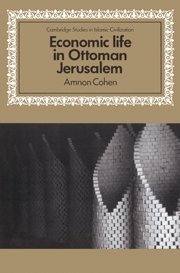Book contents
- Frontmatter
- Contents
- List of illustrations
- Note on transcription
- Map1
- Introduction
- 1 Butchers and meat consumption
- 2 Soap production and olive oil
- 3 Flour and bread
- Conclusion
- Note on abbreviations
- Note on weights, measures and monetary values
- Appendix 1 Meat prices in Jerusalem
- Appendix 2 Olive oil and soap prices in Jerusalem
- Appendix 3 Flour and bread prices in Jerusalem
- Appendix 4 A soap-factory in Jerusalem
- Notes
- Bibliography
- Subject index
- Geographical index
- Index of personal names
Note on transcription
Published online by Cambridge University Press: 10 November 2010
- Frontmatter
- Contents
- List of illustrations
- Note on transcription
- Map1
- Introduction
- 1 Butchers and meat consumption
- 2 Soap production and olive oil
- 3 Flour and bread
- Conclusion
- Note on abbreviations
- Note on weights, measures and monetary values
- Appendix 1 Meat prices in Jerusalem
- Appendix 2 Olive oil and soap prices in Jerusalem
- Appendix 3 Flour and bread prices in Jerusalem
- Appendix 4 A soap-factory in Jerusalem
- Notes
- Bibliography
- Subject index
- Geographical index
- Index of personal names
Summary
In most cases Ottoman administrative terms as well as place names have been transcribed in their Arabic form. Although their pronunciation may have been largely influenced by the Turkish language used predominantly by the local administration, we have followed the written form as it appears in the main source of this work: the Arabic local court records. Nevertheless, there are a few instances of administrative terms that were originally Turkish; in these cases we did not use the Arabicized version but rather the authentic Turkish form (in modern spelling). Words or names that have already become part of English usage (e.g. kadi) have been used in their accepted form.
- Type
- Chapter
- Information
- Economic Life in Ottoman Jerusalem , pp. viiPublisher: Cambridge University PressPrint publication year: 1989

